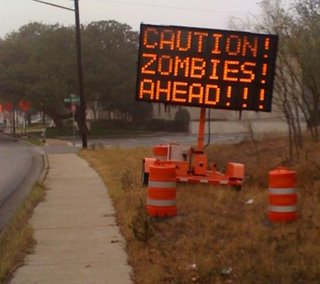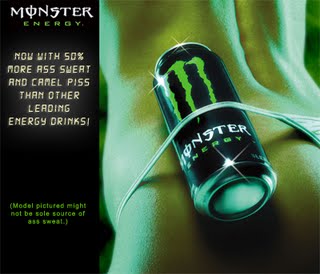 (For centuries a wanderer has traveled about during Halloween week to see what lawyers are discussing on their blogs, and presented it in Blawg Review.)
(For centuries a wanderer has traveled about during Halloween week to see what lawyers are discussing on their blogs, and presented it in Blawg Review.)
The Bogeyman was pissed. And when The Bogeyman gets pissed, it’s probably wise to listen.
“Law bloggers are trying to steal my thunder,” he hissed, “It used to be that I had dibs on scaring the bejesus out of people. Now only 40% believe that my coterie of demons inhabits this earth. And I blame the lawyers. What are you guys trying to do to me?”
So as I stepped from my home to trick-or-treat with Little Man and Sweet Pea, he said “I’m coming along to show you what I mean.” Oh, great.
We stopped at the house of Canadian law professor Sharon Sutherland who told us, while she tossed twizzlers into my kids’ bags and blasted Thriller into the street, that there were more than 200 mentions of zombies in case law over the last 50 years, with most occurring in the last decade.
 “See what I mean?” said The Bogeyman, “I’m supposed to control all the zombies. I mean, I can still invade a few brains to alert the world to real Zombies, and rattle a few people on the street, but too many lawyers are grabbing my turf.”
“See what I mean?” said The Bogeyman, “I’m supposed to control all the zombies. I mean, I can still invade a few brains to alert the world to real Zombies, and rattle a few people on the street, but too many lawyers are grabbing my turf.”
“I mean, really, Zombie law firms! Isn’t society overusing my minions?
He was on a roll while my kids were chattering happily, looking to score some Nerds. Maybe Scott Greenfield could get the kids sugar-zonked, while transporting me somewhere pleasant away from zombies. But Greenfield was spooked. He saw a prosecutor, once imbued with power, who was fired and then blogged about it. And now he’d vanished into the ethers, leaving behind his unpleasant ghost.
My kids were unimpressed with this tale, despite the Ghostbusters soundtrack playing in the background. They wanted gore. And so did The Bogeyman.
So we stopped at Kevin Underhill’s, because he had a fish knifed into his door, and this, oddly enough, got my kids excited. Was this some Godfatherish death warning to Halloween tricksters, I wondered? And what happened to the fish killer asked the kids? My kids scored some gummy fish and scampered away.
Animals are fun, said Little Man, but can we find some live ones next time? Well, we could always find people humiliating their pets. “Fun!” said the son. “There oughta be a law,” groused The Bogeyman as his eyes started to glow.
Next door was sweet, old Mother Jones; perhaps she could spook the kids? But Mother was too busy laughing while nibbling on a pop tort. It seems that the tort reformin‘, lawsuit hatin‘ US Chamber of Commerce had been punked when a group parodied them. And they not only threatened a suit of their own but were actually dumb enough to start one. My daughter looked up and asked, “Is this where the phrase ‘good for thee but not for me’ comes from?” Smart kid. Mother didn’t spook, but she did spoil, with a fistful of vegan candy. My kids pretended not to notice. They’re good that way.
Then they raced down the street to the little niche that Mark Herrmann and Jim Beck share. Not that there’s anything wrong with that. Together they looked down at my happy little munchkins: “If you ever grow up to be drug company executives,” they thundered in unison, “Stay out of West Virginia! For the learned intermediary doctrine won’t apply!” I’d never seen my kids’ eyes grow so wide. I don’t know if it was fear or bewilderment, but they scampered away quickly, without even realizing the candy wrappers were completely filled with warning labels.
The little ‘uns had no interest in discussions of drug company law, nor hypocritical faux “reformers,” they wanted monsters, and not the monsters that inhabit law schools. So we went in search of something …monstery? The Bogeyman was salivating. Finally.
 While the kids were distracted chewing on Twizzlers, I told The Bogeyman about Monster Energy Drink and their chuckleheaded lawyering that managed to pull two bone-headed moves, trying to crush the free speech of a website that gave them a negative review, and trying to stop a small Vermont brewery from making Vermonster Beer.
While the kids were distracted chewing on Twizzlers, I told The Bogeyman about Monster Energy Drink and their chuckleheaded lawyering that managed to pull two bone-headed moves, trying to crush the free speech of a website that gave them a negative review, and trying to stop a small Vermont brewery from making Vermonster Beer.
See? Monsters! The Bogeyman still wasn’t impressed — and if you’ve ever tried to impress The Bogeyman you’ll understand how difficult this task is — so we went next door to IP guru Ron Coleman.
“The End Days are here,” he said cryptically while Bad Moon Rising poured forth, and I saw The Bogeyman start to smile, making my stomach turn. Coleman explained to me, while tossing M&Ms at my kids, that “abusive DMCA takedown notices sent by copyright owners” will alter Google for the worse. “It’s over.” Dennis Kennedy, who snuck up behind us in the doorway with is own little troop, says he thinks that Google’s best days are behind it as the next generation of search arrives. As we walked away, Mr. B said that my neighbors had awfully skewed perspectives on what End Days really means.
And then came a cheery call to us from Eoin O’Dell, temporarily in the US, who was researching the law of haunted houses and whether there was a duty to disclose a haunting in a house sale. And if you don’t believe me, you can check his citation to a New York appellate court. But the only appeal for the children were the brightly colored sucking candies she brought with her from overseas.
The Bogeyman told me he was getting annoyed, but saw promise as we hit the walkway to Bruce Carton‘s place. Hanging from a tree was an effigy with all manner of injuries. He’s wearing a Mets jersey, representing a season to forget. As we rang the doorbell, my son questioned me on a conundrum: Yankees or Phillies? As Mets fans we hate both. But when Carton gets an earful of our discussion, he can’t wait to tell the story of the gorgeous tall buxom blonde — in desperate need of two World Series tickets and what she will do to get them. Baseball, I tell my kids, is all about scoring, and I get them the hell out of the house.
 But the talk of sex has caught the happy ear of next door neighbor Kashmir Hill, with gravestones sticking up from her front lawn. She pointed toward one of them, with the name of the 66 year-old assistant district of attorney caught with the 18 year-old stripper. Caught, she adds, in a graveyard. Douglas Keene, visiting with Hill, chipped in with more while the kids happily tangled themselves up in the spider webby stuff that Hill hung from the trees: Keene whispered that it was now possible to look at someone’s Facebook account and determine their sexual orientation. The Bogeyman was going apoplectic. “Give me real villains,” he snarled. His left ear started to smoke.
But the talk of sex has caught the happy ear of next door neighbor Kashmir Hill, with gravestones sticking up from her front lawn. She pointed toward one of them, with the name of the 66 year-old assistant district of attorney caught with the 18 year-old stripper. Caught, she adds, in a graveyard. Douglas Keene, visiting with Hill, chipped in with more while the kids happily tangled themselves up in the spider webby stuff that Hill hung from the trees: Keene whispered that it was now possible to look at someone’s Facebook account and determine their sexual orientation. The Bogeyman was going apoplectic. “Give me real villains,” he snarled. His left ear started to smoke.
“And if you can’t make me sick, at least try to amuse me.” So I showed him Adrian Dayton‘s idea of a funny Halloween costume, focusing on social media. And Ann Althouse with her werewolf. “You humans can’t even do humor right, though the CEO that dressed in six different Halloween costumes for his deposition was at least a good effort,” said The Bogeyman. “As was the guy who came to see the Utah Attorney General dressed in full SWAT gear. But you’re mostly pathetic. In some places, it could even be a felony to wear a Halloween mask. If you want costumes, look at this commercial one of my people did, though you should tell your more cowardly readers not to blast the volume if they’re sneaking a peak at work.”
When we walked up to the home of Jeralyn Merritt, she was outside talking about abuse with Ken from Popehat. Jeralyn pushed a deep dish of mini-chocolates toward my kids without breaking stride in the story she was telling of the six Gitmo Uighurs that had finally been freed and finally found a home, though it wasn’t their own. And Ken was talking about abuse elsewhere: when a southwestern hotelier demanded that his Spanish-speaking employees cease and desist their native language because he feared they are secretly mocking him behind his back. Maybe he deserved to be mocked?
My kids strolled into the house, and The Bogeyman pulled me aside. You call this Halloween? Where are the real goods? With my kids now safely out of sight, I took him around the corner…
We found Howard Wasserman at the next house, with its glowing jack-o-laterns out front and Black Magic Woman filling the air. He was starting a Suicide Pool, watching as “Birther” lawyer and nut job (and dentist!) Orly Taitz continued down a path that has already had her sanctioned and will likely to cost her her license when done. “That’s not real death,” growled The Bogeyman.
OK, I told him, I’ll give you a taste of the real deal.
Anne Reed greeted us ever so quietly where she sat on her front porch with a simple un-carved pumpkin. And she told us of the murder trial of a 4 year old girl, and the artwork created by a juror. She was sitting with Tom Kirkendall who told of the tragic car accident death of Houston trial lawyer John O’Quinn. Ashby Jones, who had just joined them, shared the story of real life monster Radovan Karadzic, the Serb accused of war crimes in Bosnia, whose war crimes trial was about to start at The Hague.
 The four of them had an open laptop, and were looking at the site of Chicago Now. I think we found some of your friends living here, I whispered to The Bogeyman. The tatooed faces in these mug shots seem to scream out that evil was here.
The four of them had an open laptop, and were looking at the site of Chicago Now. I think we found some of your friends living here, I whispered to The Bogeyman. The tatooed faces in these mug shots seem to scream out that evil was here.
The Bogeyman smiled and quieted down as he saw the fruits of some of his labors. He drifted off aways.
But Kevin Underhill had left his home to follow me, and now reappeared. He wanted to tell me, as if to taunt The Bogeyman back into my life, that he was most unimpressed. Those tats can be creatively covered up…just look what this guy is planning to do with his.”
 With The Bogeyman’s blood thirst hopefully sated, despite Underhill’s efforts, I scooped up my kids and headed to the home of John Hochfelder. He had a roaring fire in a pit on the front patio to break the late October chill, and Phantom of the Opera played quietly in the background. The parents drank wine and beer as the kids roasted marsh mellows into a goopy mess that were then decorated with candies in a gross-out contest. While Hochfelder served the booze, he also talked to us about the problem a certain Halloween witch had when she got drunk and was then hit by two cars, one of which was the responding police.
With The Bogeyman’s blood thirst hopefully sated, despite Underhill’s efforts, I scooped up my kids and headed to the home of John Hochfelder. He had a roaring fire in a pit on the front patio to break the late October chill, and Phantom of the Opera played quietly in the background. The parents drank wine and beer as the kids roasted marsh mellows into a goopy mess that were then decorated with candies in a gross-out contest. While Hochfelder served the booze, he also talked to us about the problem a certain Halloween witch had when she got drunk and was then hit by two cars, one of which was the responding police.
Gideon — who had been talking to others about his beliefs on good and evil and the differences between those in the dock and those sitting in justice — shifted gears to join the drunk driving discussion. He noted a little dissent where Chief Justice Roberts argued that anytime police receive an anonymous tip that someone is driving drunk they should be able to pull them over and conduct an investigatory stop.
But stories of drunks don’t always have to end with death and destruction, and Jonathan Turley hoisted a tankard of suds to the cop that pulled a gun on a character in a haunted house. Hey, he said, no one got hurt. The Bogeyman, standing under a tree in the distance, started to glow again as his nostrils flared out almost to his ears.
Siouxsielaw sat with us by the fire — having just moved into the neighborhood as the planet’s first Gothic law blogger. Talk about your niche areas. But she wanted to return to Hochfelder’s witch case. It seems that the Supreme Court of Massachusetts has allowed a Halloween costume to be admissible in a sex discrimination lawsuit. Siouxsie, by the way, also has a Halloween waiver and has a trick or tort posting and a motto that “Good Lawyers Wear Black?” Is this blogger a keeper? Me thinks so, I told the crowd.
As the night wore down and I scooped up the kids to leave, I collared Bill Childs and thanked him for doing a round-up of the personal injury discussions of the past week, because I surely didn’t have the time to do so here. When he said that newcomers to this site really wouldn’t get a true taste of my blog by reading my account of this evening, I reminded him that they could simply go to the “greatest hits” page that I have.
And when Blawg Review #237 hits Chritsian Metcalfe’s property law blog next week, hopefully The Bogeyman will stay home.
Links to this post:
Five Years of Blawg Review
Five years; what a surprise! #1 Legal Underground; #2 Likelihood of Confusion; #3 Appellate Law & Practice; #4 Law & Entrepreneurship; #5 Conglomerate; #6 South Carolina Trial Law; #7 Jeremy Richey’s Blawg; #8 Crime & Federalism
…
posted by Editor @ April 11, 2010 12:06 AM
Nominations For Blawg Review Of The Year: 2009
Blawg Review is a weekly “blog carnival,” a round-up of links to recent posts from different weblogs on legal topics. Often the review itself is organized around a theme, though it need not be. We were honored with an invitation to host
…
posted by Patrick @ December 30, 2009 10:18 AM
Blawg Review is like a box of chocolates…
The anonymous and always-enigmatic Editor of Blawg Review (not pictured above) offers a “sampler” of each of the past year’s editions of the carnival of legal blogging in this week’s Blawg Review #244. For obvious reasons I was reminded
…
posted by Colin Samuels @ December 28, 2009 8:00 PM
Blawg Review #244
Christmas Sampler shared by chinbit on photobucket Blawg Review is the blog carnival for everyone interested in law. A peer-reviewed blog carnival, the host of each Blawg Review decides which of the submissions and recommended posts are
…
posted by Editor @ December 28, 2009 12:01 AM
If there’s no Blawg Review in Disneyland, can it really be the …
One of the pleasures of living in California is the state’s sensible tax policy that one can go to Disneyland about as frequently as one wishes and one’s pocketbook permits. Fortunately, last week was one of those wondrous times when
…
posted by Colin Samuels @ November 10, 2009 11:00 PM
Not Just Another Content Scraper. Emery Ledger’s Content Scraper
The problem of running a blog that produces, to small small degree, original content about a topic of interest to many laypeople (in our case law) is that one gets so many sincere flatterers. Ordinary spammers are bad enough. though we
…
posted by Patrick @ November 06, 2009 4:15 PM
Blawg Review #236 – Halloween Edition by Eric Turkewitz
Eric Turkewitz writes a ‘mean’ Blawg Review… and I mean that in the Cowboy Western ‘mean an ornery’ sense…of the word I heard as a child when I was transfixed by Rawhide, Gunsmoke et al. From a Marathon themed Blawg Review,
…
posted by charonqc @ November 05, 2009 2:16 PM
Bonfire Night @blawgreview
Remember, remember the Fifth of November… quoting Scott Leviant’s Blawg Review #221. So I promised that I wouldn’t dwell on “that blawger,” the author of Charon QC and notorious host of several Blawg Reviews.
…
posted by Editor @ November 05, 2009 11:31 AM
Halloween Blawg Review
I don’t know if Eric Turkewitz remembers me suggesting he use this one of Hugh MacLeod’s Gaping Void cartoons on the back of a business card for his “blog card”. This week, Eric tries to find happiness hosting his third Blawg Review,
…
posted by Editor @ November 02, 2009 2:08 PM
Monday Blawg Reviewing
Eric Turkewitz does a bang-up job on a spooky Blawg Review #236 over at his New York Personal Injury Law Blog. Enjoy. You know, blawg reviews are hard. The one we did was exhausting. You have no idea how time-consuming it was for me to
…
posted by Ken @ November 02, 2009 11:03 AM
Blawg Review #236
Is on a Hallowe’en theme, at Eric Turkewitz’s.
posted by Walter Olson @ November 02, 2009 7:37 AM
Flickr Tweet, Wascally Wabbit
RT @infobunny Why does no one call me pumpkin? Blawg Review #236, hosted by Eric Turkewitz, is a real treat. Note to @Geeklawyer and friends, who celebrated Halloween at the #brightonpissup4, “pissed” also means “angry” to a Yank.
posted by Editor @ October 30, 2009 9:41 AM











